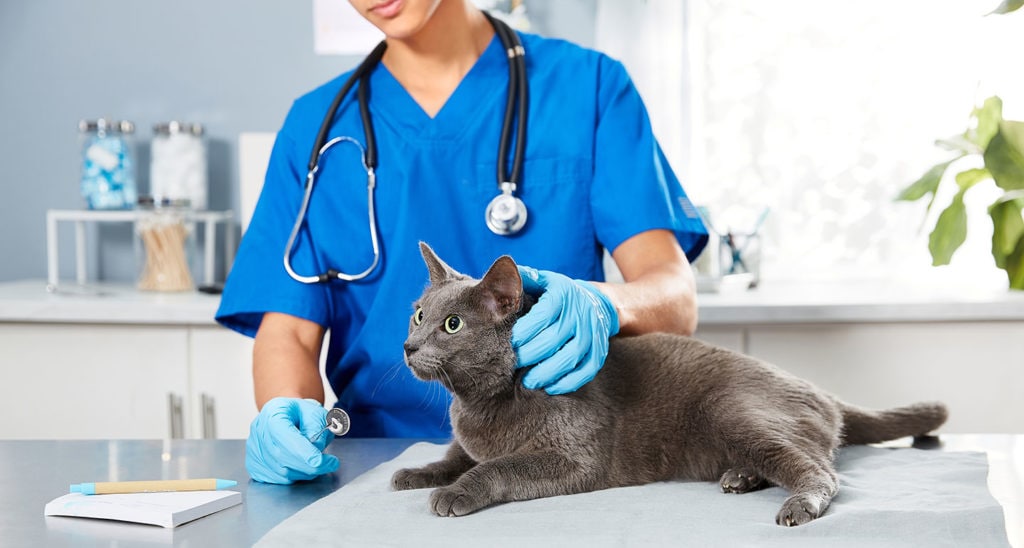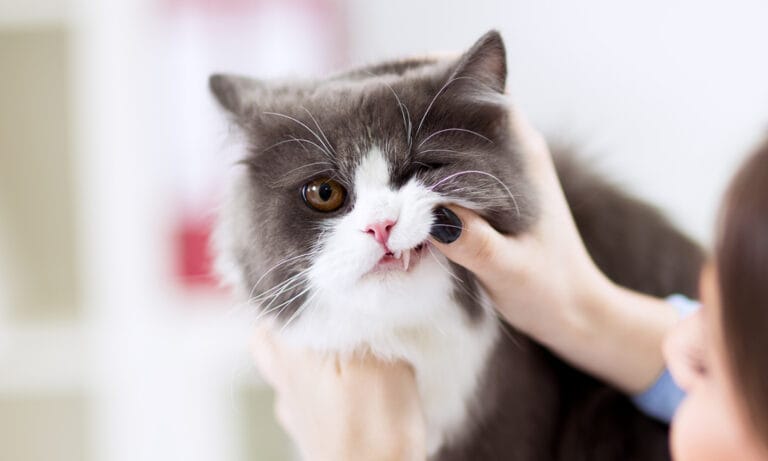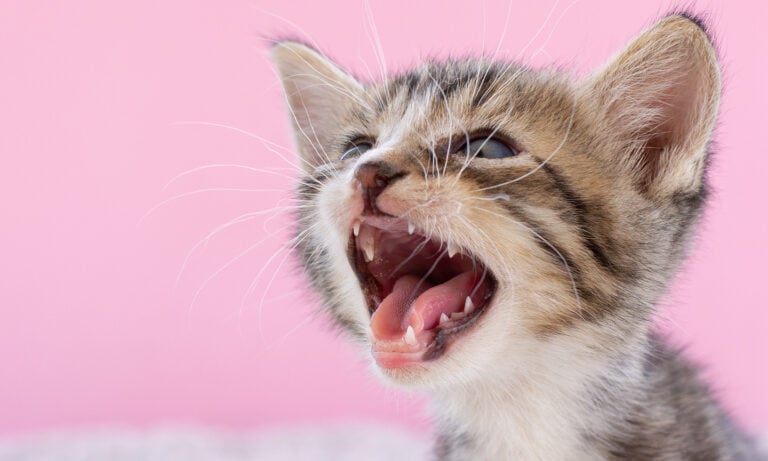I’ve lived with cats almost my entire life, yet it wasn’t until about 15 years ago that I really started hearing about how important regular dental care is for felines. In fact, it’s super important because it helps prevent dental disease in cats.
At-home care is not enough. Your pet also needs professional cat dental cleanings.
Common Dental Diseases In Cats
If you’ve ever had tooth decay, an abscess or infected gums, you know how painful that can be. And cats are stellar at hiding their pain and discomfort, even when their mouths are involved. There are two main types of dental disease that affect cats:
- Periodontal Disease
- Tooth Resorption
It’s estimated that 85 percent of cats have periodontal disease by the time they are 6 years old. As we see in our own mouths, bacteria in the mouth forms plaque on the surface of the teeth. Minerals in the saliva harden the plaque into tartar, which spreads under the gum line where real damage occurs. This preventable disease includes gingivitis (inflamed gums) and periodontitis (loss of bone and soft tissue around the teeth), which leads to tooth loss.
In addition, 50 percent of adult cats over 3 years of age have tooth resorption, says Dr. Jan Bellows, a board-certified dental canine and feline specialist and owner of All Pets Dental in Weston, Florida. It is unclear what causes tooth resorption, also called feline odontoclastic resorptive lesions (FORL). The lesions that develop are acutely painful and break down the teeth material to disintegrate the root and the crown. Most cases require extraction of the affected teeth.
At-home dental care, such as brushing your cat’s teeth daily, reduces the chances of cats developing periodontal disease. But based on the percentage of cats with periodontal issues, we’re not keeping Kitty’s teeth clean enough at home. That’s where cat dental cleanings come into play.
Professional Cat Dental Cleanings
Like me, you might wonder when and if it might be time for a professional cat dental cleaning. Of course, your vet is the best person to give you a heads up that Kitty needs a professional cat teeth cleaning.
When It’s Time to Call In the Pros
“If at your cat’s annual visit, the vet notices red gums or heavy tartar accumulation or bad breath, that indicates it’s time for teeth cleaning,” says Dr. Lisa Fink, a board-certified veterinarian with a specialty in dentistry and oral surgery at Cornell University Veterinary Specialists in Stamford, Connecticut.
If you’re paying close attention, however, you already might see indicators at home.
“Dropping food, not wanting to eat, going up to the food bowl and running away from it, all are signs of oral pain,” Dr. Fink says.
Your cat still might have an appetite, but you notice they tilt their head and tries to chew on just one side. Swallowing kibble without chewing also might signal a problem.
Drooling, change in behavior, bad breath and pawing at the mouth also can indicate something is wrong.
“Mouth odor is late along the regimen; by that time, it’s periodontal disease,” Dr. Bellows says. “Flip or pull back the lips and look for yellowish or brown [tartar] on tooth surface. If it’s there, it’s time for a dental cleaning.”
While the frequency of professional dental cleaning varies from cat to cat, Dr. Fink says every 1 to 2 years is generally recommended. She adds that though “we might read a lot about purebred cats, such as Siamese, having ‘worse’ teeth, any breed of cat can have problems, from purebred to domestic shorthair.”
This is where at-home care and diet come in to play.
“A client’s attention to home care affects it the most.” Dr. Bellows says. “If [cat parents] take a Q-tip—soaked in tuna water helps—to the gum surface (where the gum hits the tooth) once a day after the cleaning to remove the plaque, they usually don’t need another cleaning for years. If not, every 6 months to a year. It also depends on what they eat.”
What to Expect During a Cat Dental Cleaning
The cleaning procedure will vary from veterinary practice to veterinary practice, but dental specialists say there are some standard steps we can expect. Those are:
Those are:
- Examination: The vet will examine the cat for general health and review their previous dental history, and check to see if any other tests need to be done, such as blood tests to test liver, kidneys and sugar level, or a urine test. Older cats get an electrocardiogram (EKG) as well as a blood pressure test, chest and abdomen X-rays, and a thyroid test, Dr. Bellows says.
- Anesthesia: If cleared for the procedure, the vet will anesthetize the cat and put a soft tube down the windpipe to support their breathing and prevent aspiration of water and oral debris.
- X-rays: Dr. Bellows says dental X-rays are advised for every case because a dentist can’t diagnose below the gum line without it.
- Teeth Cleaning: Then the teeth are cleaned above and below the gum line with an ultrasonic scaler and polished. At this point, you would receive a call from the vet to hear what’s been found and what treatment is recommended, Dr. Bellows says, adding that “some vets set up a separate appointment for any extractions, but for less stress and expense, I do it at the same time.”
- Protective Sealant: Finally, they put a dental sealant designed to prevent periodontal disease on the cat’s teeth, he adds.
This is just a general outline. Dental specialists also recommend asking questions about your vet’s dental work and anesthetic protocols.
Common Concerns About Cat Dental Cleanings
Though, as pet parents, we can recognize the benefits of cat dental cleanings, they are not without concern.
Anesthesia
Veterinary dentists agree that the biggest concern most cat parents express about professional cat dental cleaning regards anesthesia.
“As long as the preoperative blood work is normal and the heart and lungs are normal, the risk of death from anesthesia is very low, about 0.1 percent,” Dr. Fink says.
Dr. Bellows agrees that with veterinary dentists doing more preoperative work and monitoring than ever before, the anesthetics are safer than before. Experts, including the American Veterinary Dental College (AVDC), do not recommend non-anesthetic or anesthesia-free dental scaling, because they say anesthesia is the only way to keep the cat pain-free during the procedure and allow the dentist to thoroughly inspect the teeth and remove all the tartar from underneath the gums.
Dr. Fink adds that with an awake animal, the airway is not protected, so flushing with water can cause damage to the soft tissues. Even I find a routine dental cleaning barely tolerable at times, and I’m able to express my pain and I understand the importance of the work being done in my mouth. My cat would have no way of understanding what’s going on, and fight the dentist through the entire procedure. So, I certainly can appreciate why anesthetic scaling is the recommendation.
Cost
Cat teeth cleaning cost can be another big concern for us. This, too, will vary by practice, the vet’s qualifications and the cat’s health. You can expect to spend anywhere from $300 to $1,400 for a cat dental cleaning.
“Every vet charges differently, and it depends on the condition of the pet and what’s found,” Dr. Bellows explains. “Teeth cleaning itself is a small part. The preoperative blood work and other necessary diagnostics is one charge, the actual procedure of IV and anesthesia is another cost, teeth cleaning and X-rays is another cost, finding disease and needing extractions is another cost. The big part is that the cat really needs it, and it’s more than just a teeth cleaning; cats can have other problems going on.”
If teeth are extracted, pain management will be used during and after the procedure, and treating periodontal disease might require antibiotics, Dr. Fink adds. That’s an additional fee that contributes to the overall cat teething cleaning cost.
Picking a Pro
“In the wrong hands, dentistry can be risky because sharp instruments used in the wrong way can cause lacerations and injuries,” Dr. Fink says.
As cat parents, we obviously want to keep those risks low, and one way we can do that is to make sure the people working on our pets have the appropriate equipment and training. So don’t be shy: Ask about who’s going to be in there with your cat, and their experience.
“With capable employees and properly trained people administering the anesthesia, there’s a low risk of death from anesthesia,” Dr. Fink says. “Ask. Make sure someone is dedicated to monitoring the animal (for heart rate, blood pressure, electric activity of the heart and oxygen saturation), seeing if there are any sudden changes, and acting accordingly.”
Dental X-rays are essential to the procedure, because 60 percent of the tooth is beneath the gum line. These X-rays guide the treatment plan for affected teeth, so you want professionals who have the proper X-ray equipment and know how to interpret dental X-rays, she adds.
To find a board-certified dental vet, you can check out the American Veterinary Dental College’s website.
Is It Too Late?
My cats still have all 30 adult teeth, but it turns out that even if they start to lose teeth or have other signs of dental ill health, it’s not too late for a professional dental cleaning and care to relieve their pain and retain their good teeth.
Share:









